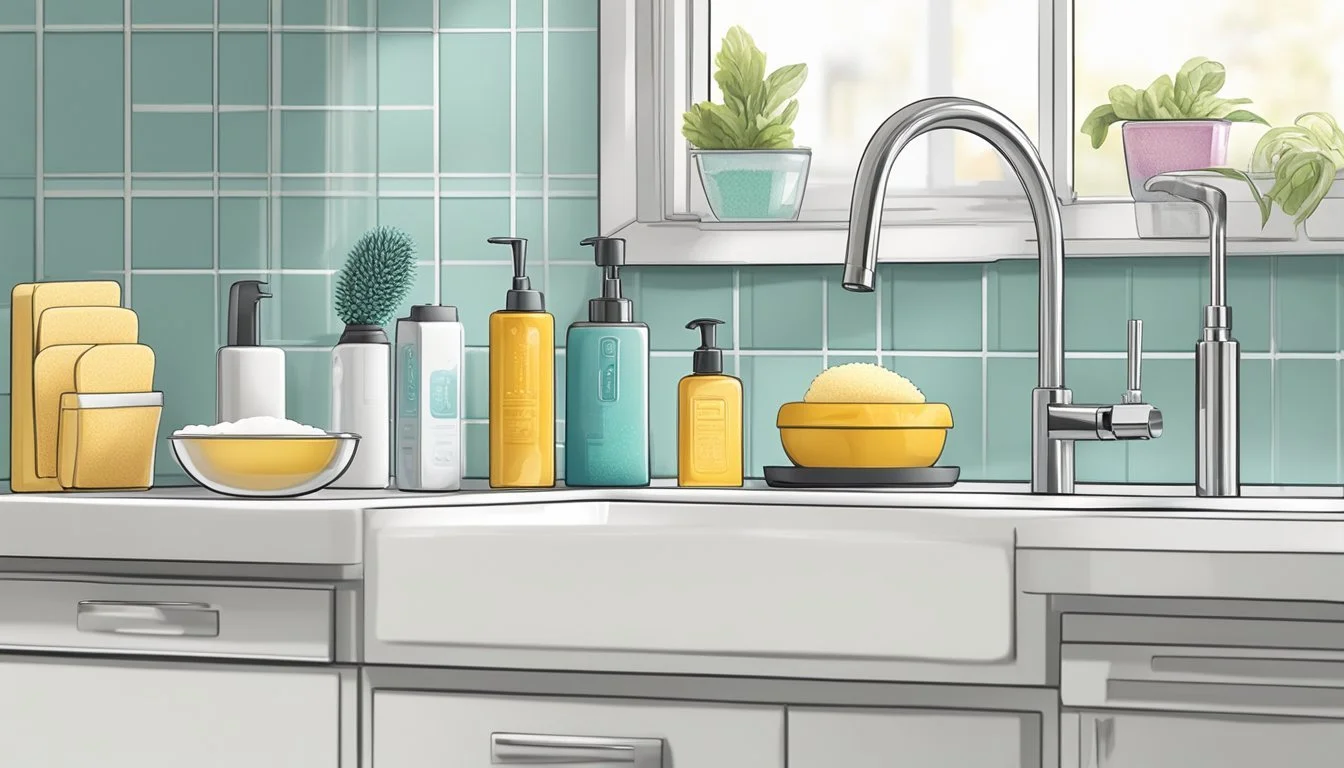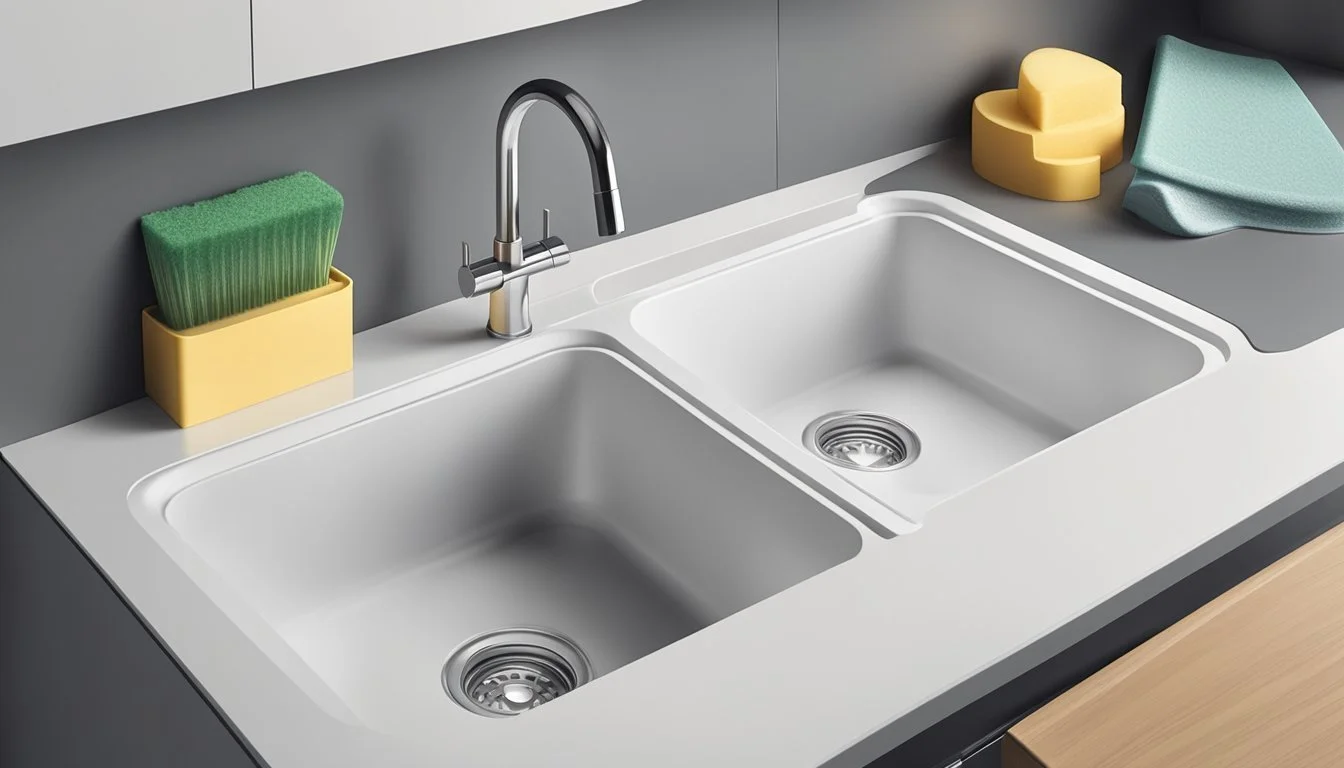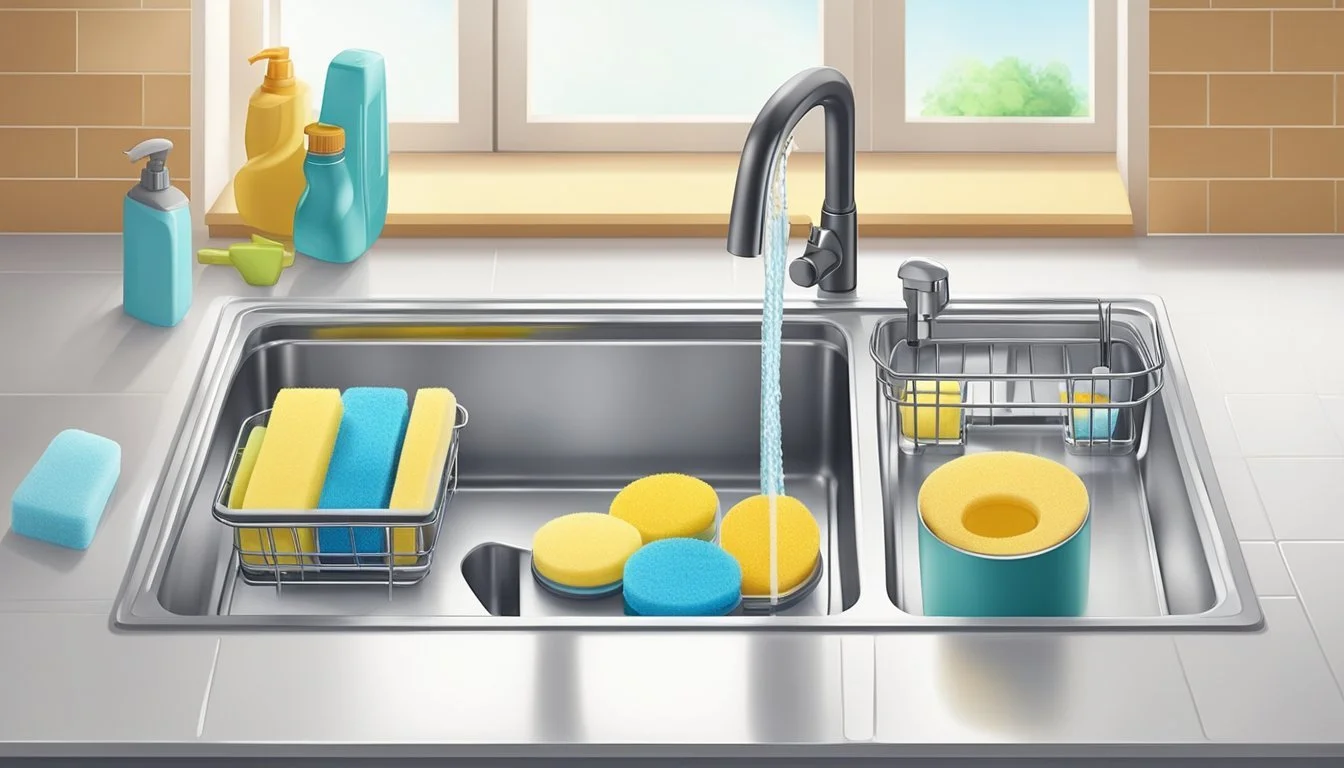5 Clever Ways to Store Your Dish Soap and Sponges
Space-Saving Kitchen Tips
In the heart of every home, the kitchen is a bustling hub of culinary activity, often becoming a repository for dish soap and sponges. Given their frequent use, it becomes essential to store these cleaning stalwarts in a way that is both clean and convenient. Proper storage solutions not only keep the kitchen tidy but also ensure that these tools are readily at hand when it's time to tackle the aftermath of a home-cooked meal.
Creative storage ideas can transform the cluttered kitchen into an oasis of organization. Many seek innovative methods to store dish soap and sponges, aiming to enhance accessibility and maintain hygiene. Options such as incorporating a lazy Susan for ease of reach, or using magnetic holders for sponges, cater to the need for practicality without sacrificing the kitchen’s aesthetic appeal. With suitable storage strategies, one can ensure that the cleaning essentials are effectively organized, elevating the efficiency of kitchen routines.
Assessing Your Space
Before introducing any new storage solutions for dish soap and sponges, one must take stock of their kitchen's layout and existing storage facilities.
Understanding Kitchen Layout
The kitchen layout plays a critical role in determining where and how dish soap and sponges can be stored. For those with small spaces, options may be more limited, making efficient use of kitchen sinks and nearby areas paramount. An individual should note the proximity of the sink to cabinetry or potential shelves, taking into account the workflow and ease of access when hands are wet or occupied.
Identifying Storage Opportunities
Once familiar with the kitchen's layout, identifying potential storage opportunities becomes the next step. Herein, the focus is to spot unused or underutilized areas that can serve as clever organization points. Common storage areas include:
Under-sink cabinets: Ideal for larger items or bulk storage.
Kitchen shelves: Effective for items needed at hand, can be on walls or as open shelving.
Pantry: For storing back-stock of cleaning supplies.
One should examine each of these areas for their suitability to house dish soap and sponges, considering factors like moisture exposure and ease of cleaning. Open shelving can be aesthetically pleasing and practical for frequently used items, making them an alluring option for those wishing to display their kitchen storage solutions.
Choosing the Right Organizers
When selecting organizers for dish soap and sponges, one should consider materials for longevity and the specific type of organizer best suited for their kitchen.
Evaluating Materials and Durability
The materials of organizers play a crucial role in durability and maintenance. Stainless steel sponge holders resist rust and are easy to clean, making them a long-lasting choice. Plastic trays can be lightweight and cost-effective but may not endure as long as metal or ceramic options. Ceramic holders typically offer an aesthetically pleasing look and are sturdy, though they can break if not handled carefully. It is vital for the buyer to assess their kitchen's environment and choose a material that withstands frequent exposure to water and soap.
Types of Organizers: Hooks, Trays, and Holders
Hooks
Adhesive Hooks: Ideal for hanging sponges to dry, ensuring they are not left in puddles of water.
Suction Cup Hooks: Attach to the inside of the sink or tiles without the need for drilling.
Trays
Draining Trays: Prevent water from collecting and encourage sponges to dry faster.
Sliding Trays: Often mounted under the sink; they slide out for easy access to dish soap and sponges.
Holders
Sponge Holders: Keep the sponge off the countertop and are often designed to facilitate drying.
Basket Holders: Provide a space for both dish soap and sponges, helping to declutter the sink area.
It's also beneficial to utilize labels if using baskets or bins for multi-item storage, which aids in maintaining organization. Additionally, consultation with a professional organizer can offer personalized solutions for a kitchen's specific layout and storage needs.
Strategies for Sponge and Soap Storage
Maintaining an organized kitchen involves clever storage solutions that ensure items are both hygienic and within reach. The following tips will focus on strategies for keeping sponges dry and germ-free, as well as making dish soap easily accessible.
Keeping Sponges Dry and Germ-Free
Sponges can harbor bacteria and germs if not stored properly. To prevent this:
Use a sponge holder with proper ventilation. This enables the sponge to dry fully between uses, discouraging bacterial growth.
Sanitize sponges regularly by microwaving them for two minutes, placing them in the dishwasher with a drying cycle, or soaking in a vinegar solution.
Storing Dish Soap for Easy Accessibility
Dish soap should be at one's fingertips without causing clutter. Here's how one can store it:
Utilize a soap dispenser near the sink to keep dish soap handy and mess-free.
Place dish soap within a sink caddy or on a lazy Susan to ensure it is accessible and secure.
Integrating Storage into Your Workflow
Effective storage integration in the kitchen streamlines tasks and keeps essential cleaning items like dish soap and sponges at hand without cluttering the workspace.
Clever Uses of Kitchen Furniture
Kitchen Island: A kitchen island can serve as a central hub for storing dish soap and sponges. By installing a pull-out drawer or a hidden compartment, one ensures these items are accessible yet out of sight. This technique maintains a clean aesthetic while keeping the essentials within easy reach during food preparation or cleanup.
Hutch: For those with a traditional hutch, using a small, dedicated section to organize dish cleaning supplies can transform this piece of furniture into a practical storage solution. Well-placed dividers within the hutch can turn a shelf into an organized station for sponges and soaps.
Customizing Storage for Efficiency
Serving Trays and Cookie Sheets: Employing these items as drawer dividers creates distinct spaces for storing sponges and dish soap bottles. They can be sorted neatly within drawers or cabinets, allowing for quick access and efficient use of space.
Cutting Boards: A cutting board with an integrated groove can be repurposed to hold dish soap and sponges when not in use. This approach reduces clutter on counters and makes use of existing kitchen tools, adapting them to storage needs.
Aesthetic and Functional Decoration
Incorporating effective storage into your kitchen decor can both enhance the room's appearance and improve functionality. This section explores how to stylishly store dish soap and sponges using open shelving and serving dishes, while also ensuring these items are easily accessible.
Using Open Shelves for Display and Ease
Open shelves offer a balance between functionality and visual appeal, where one can arrange kitchen essentials such as dish soap and sponges. Consider these shelves as a stage for your dishwashing accessories:
Plates and Bowls: Place dish soap and sponges in small decorative bowls or plates to keep them tidy yet reachable.
Visibility: Keeping these items on the lower shelves makes them easy to grab when needed and can prevent clutter around the sink area.
Adding Personality with Serving Dishes and Linens
Serving dishes and linens don't have to be stowed away when not in use. They can double as holders for cleaning items, adding a subtle touch of personality:
Serving Dishes: Use an attractive serving dish to hold sponges or a soap dispenser, turning a mundane item into a point of interest.
Table Linens and Napkins: Wrapped around a container, colorful napkins can conceal spare sponges or cloths, providing a vibrant pop of color while keeping your supplies neatly organized.
Maintenance Tips for Long-Lasting Cleanliness
Maintaining a clean space for dish soap and sponges involves two critical practices: controlling moisture and minimizing bacterial growth, and keeping up with regular cleaning and reorganization. These practices help ensure hygiene and extend the usefulness of kitchen cleaning tools.
Minimizing Moisture and Bacterial Growth
Moisture is a breeding ground for bacteria. To combat this, one must ensure that sponges and dish soap are stored in a way that reduces moisture. A sponge holder that allows air circulation and a soap dish with proper drainage can be effective solutions. Drying towels may be used to absorb excess moisture. Towels should be washed regularly to prevent the build-up of bacteria themselves.
Sponge Holder: Use one with ventilation.
Soap Dish: Choose one with drainage.
Towels: Launder frequently to avoid bacterial growth.
Regular Cleaning and Reorganization
Sponges and dish soaps require periodic cleaning to remain hygienic. Sponges should be sanitized through methods such as microwaving damp sponges or placing them in dishwasher cycles with a "sanitize" option if available. This kills bacteria that can accumulate over time. Additionally, one should routinely clean the soap dish and sponge holder to remove soap scum and debris. Reorganizing these items ensures that they stay in an optimal condition for use.
Sanitizing Sponges:
Microwave damp sponges for 1-2 minutes.
Use the dishwasher's "sanitize" setting if suitable.
Cleaning Holders: Weekly scrubbing of soap dishes and sponge holders.
Reorganize: Assess the arrangement periodically for maximum hygiene and functionality.
Creative Solutions for Compact Kitchens
When space is at a premium, every inch counts. Compact kitchens must employ smart strategies to store dish soap and sponges without cluttering valuable counter space.
Maximizing Vertical Space with Pegboard
Installing a pegboard provides a flexible and easily accessible storage system. They can utilize hooks to hang caddies or small baskets that keep dish soap and sponges within reach but off the countertops. Pegboards can be customized with:
Hooks for hanging items
Shelves for larger bottles of dish soap
Small containers for fresh sponges
Multi-functional Furniture for Storage
Kitchen islands often come with built-in storage options. In compact kitchens, they can take advantage of a kitchen island that serves as both a prep area and a clever storage solution. Consider a kitchen island that includes:
Drawers for storing sponges and cleaning cloths
Side racks for hanging spray bottles of cleaning agents
A hidden pull-out bin to store dish soap and brushes discreetly
By integrating storage into furniture, they maximize the functionality of every piece in a small kitchen space.
Organizing for the Home Cook
Effective organization within the kitchen streamlines the cooking process and keeps essential items such as dish soap and sponges tidily within reach. Well-thought-out storage solutions can also contribute to a clean and welcoming kitchen environment.
Storing Spices, Utensils, and Cookware
Spices: Cooks should store their spices in a tiered spice rack or use magnetic spice containers that adhere to the side of a refrigerator or other metallic surfaces. This not only saves space but also keeps spices visible and accessible.
Utensils and Cookware: Drawer dividers work wonders for separating utensils, while pot lids can be organized on door-mounted racks. For cookware, stacking items with the largest at the bottom and the smallest on top helps to maintain order. Adding baskets with handles to cabinets allows for easier access to items that are used less frequently.
Tips from Professional Organizers
Professional Organizers Recommend:
Utilize shelf risers to make the most of vertical space for dishes and glassware.
Invest in expandable shelf organizers to adapt to different cabinet sizes and increase storage area.
Store sponges in ventilated caddies attached to the inside of the cabinet doors to keep them dry and reduce odors.
Labeling System: Professional organizers often suggest that a labeling system is crucial to maintain the order. Labels should be clear and easy to read; bold permanent markers are useful for this.
Cookware with Multiple Uses: Opt for cookware that can perform multiple functions. This minimizes clutter, making it easier to organize and store. A simple, sturdy skillet can often be used for a variety of meals without the need for specialized pots and pans.
Conclusion
Efficient storage solutions in the kitchen can translate to a more organized and seamless culinary experience. When it comes to dish soaps and sponges, one should consider accessibility, hygiene, and aesthetic appeal in equal measure. A rotating lazy Susan allows for soap and cleaning supplies to be within easy reach, maximizing convenience. Sponge holders or trays can ensure that sponges remain dry and sanitary between uses.
For those who appreciate innovation, soap-infused sponges offer a two-in-one functionality that can be quite space-saving. Additionally, the use of decorative dispensers for dish soap can complement the kitchen's decor while keeping the soap handy.
Those concerned with the visibility and accessibility of their cleaning tools might opt for a sink-side caddy, which neatly consolidates both soap and sponges.
In summary, individuals have multiple smart options to store their cleaning essentials in a way that maintains the functionality and aesthetic of their kitchen. They can easily implement these strategies to create a more organized and efficient space.






